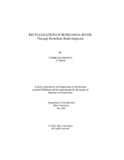| dc.contributor.advisor | Faruk, Mohammad | |
| dc.contributor.advisor | Ahmed, Iftekhar | |
| dc.contributor.advisor | Khan, Nobi Newaz | |
| dc.contributor.author | Kunimoto, Yukiko | |
| dc.date.accessioned | 2023-08-08T09:11:38Z | |
| dc.date.available | 2023-08-08T09:11:38Z | |
| dc.date.copyright | 2022 | |
| dc.date.issued | 2022-01 | |
| dc.identifier.other | ID: 17108030 | |
| dc.identifier.uri | http://hdl.handle.net/10361/19361 | |
| dc.description | This thesis is submitted in partial fulfillment of the requirements for the degree of Bachelor of Architecture, 2022. | en_US |
| dc.description | Cataloged from PDF version of thesis. | |
| dc.description | Includes bibliographical references (pages 88-89). | |
| dc.description.abstract | Throughout decades the impact of pollution on Buriganga river has been acknowledged and
studied by various researchers from a number of fields and many have also advocated the need for
riving this national asset. Projects to protect the river have also been taken up by the authorities
responsible for the rivers of this country. However, little change has been brought about in reality.
This is essentially because, despite showing a similar trend in the deterioration process with that
of other rivers around the world, every city has a unique relationship with its associated waterbody.
And hence adapting solutions that have worked in other regions may not be successful in bringing
the river back to life. This thesis is an attempt to unfold Dhaka’s relationship with the Buriganga
river from a different standpoint. Rather than predominantly focusing on the direct contributors of
pollution of Buriganga and proposing solutions to mitigate them completely, the study tries to
establish how people’s participation and engagement with the river may help to not only revitalize
the river but also ensure that it sustains. In order to do so a necessity take a more holistic approach
and put forward a comprehensive plan to redevelop the riverfront was identified. In the detailed
intervention part this idea was explored through the design of a public space at the riverfront that
will act as a force to evoke a sense of responsibility towards the river. | en_US |
| dc.description.statementofresponsibility | Yukiko Kunimoto | |
| dc.format.extent | 89 pages | |
| dc.language.iso | en | en_US |
| dc.publisher | Brac University | en_US |
| dc.rights | Brac University theses are protected by copyright. They may be viewed from this source for any purpose, but reproduction or distribution in any format is prohibited without written permission. | |
| dc.subject | Riverfront redevelopment | en_US |
| dc.subject | Buriganaga river | en_US |
| dc.subject | Waterfront nodes | en_US |
| dc.subject | Cultural hub | en_US |
| dc.subject | Old Dhaka | en_US |
| dc.subject | Pollution | en_US |
| dc.subject | Revitalization of Buriganga | en_US |
| dc.subject.lcsh | Waterfronts--Asia. | |
| dc.title | Revitalization of Buriganga River: Through riverfront redevelopment | en_US |
| dc.type | Thesis | en_US |
| dc.contributor.department | Department of Architecture, Brac University | |
| dc.description.degree | B. Architecture | |

